
Nose Job – Rhinoplasty Singapore
Natural and beautiful nose contour from bridge to tip.

Procedure Time
2 – 3 Hours

Anaesthesia
General Anaesthesia

Recovery Period
12 – 14 Days
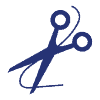
Stitch Removal
7 Days Post-op
What Is Rhinoplasty?
Rhinoplasty or nose job surgery refers to a plastic surgery procedure that alters and reconstructs the nose. Usually, there are two unique kinds of surgery procedures used – reconstructive surgery which is aimed at restoring the nose functions and form and cosmetic surgery which helps change the look of the nose.
Dream Plastic Personalised Rhinoplasty Procedure
The nose makes an important facial feature which also impacts how good other features look and integrate together for creating a balanced and proportionate appearance. A beautiful nose that has perfect height, projection and contours and harmonizes well with other facial features can really improve the looks and the confidence of a person.
Nose bridge + Tip Projection + Nose width + Any functional aspects
At Dream Singapore, we deliver customized rhinoplasty results. Creating a prominent nose is just one part to enhancing the looks of a person. What matters more is the right proportion and angles to the face. The treatment planning for a nose job takes into consideration the right angles along the forehead to philtrum.
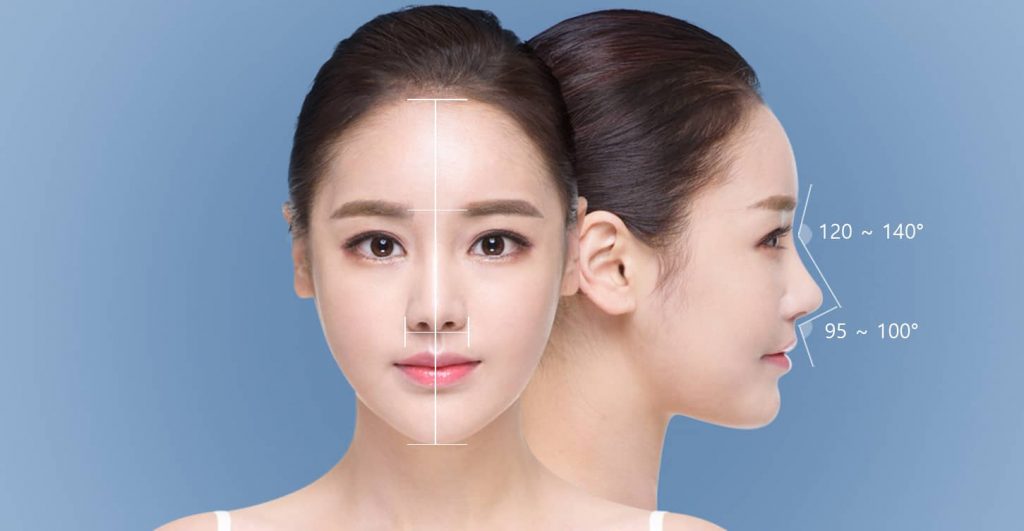
Every rhinoplasty treatment planning addresses:
- Height and volume of forehead – A higher nose bridge is helpful in drawing the facial features into the center while lending a more defined look. Good height tends to make shadows in the right areas adding definition and giving a perfect angle when looked at from the side.
- Projection and angle of nose tip relative to the chin and lip – Our Rhinoplasty procedure can change the angles as well as the tilt of the nose tip to create a different look altogether. When the nose is made slightly upturned, it looks cuter and gives a more feminine feel in comparison to a lower nose tip that often looks more mature and elegant.
- Nose width in relation to the entire face – Dream’s nose job creates a narrow nose that looks more refined and elegant.
Who Is Nose Plastic Surgery Recommended For
Rhinoplasty is appropriate for those who would like to fix:
- Flat nose with not enough projection on the tip and bridge
- Short and upturned nose that exposes the nostrils too much
- Long or arrow nose with the nose tip ending beyond the baseline and hiding the nostrils
- Nasal hump for individuals who wish to reduce that bump in the middle of the nose bridge
Below are the different rhinoplasty techniques used for addressing different types of nose concerns.
Rhinoplasty For Flat Nose
Ideal candidates:
- Individuals with overall low and flat nose
- People who have low nose bridge that makes the eyes look too much apart
- Individuals whose nose lacks definition
Surgery Method:
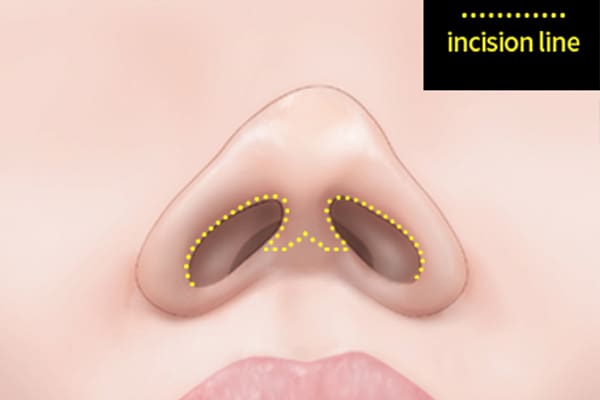
1. Rhinoplasty incision
- The surgeon makes an incision inside both the nostrils as well as along the columella
- It gives them better access into the nostrils to check the internal structure of the nose and do further examination. It also helps achieve more accurate augmentation results.
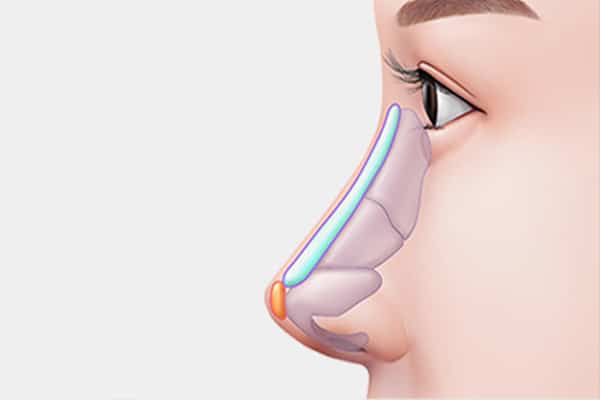
2. Enhancing the nose bridge
- The nose bridge is enhanced using silicone implants
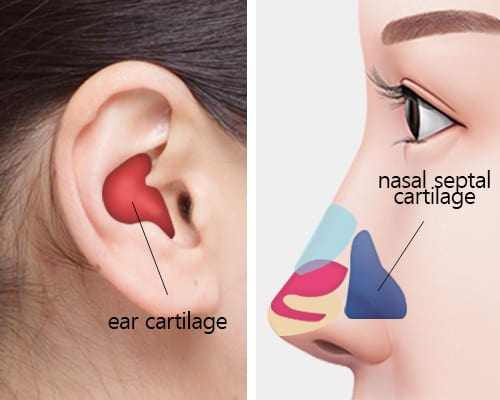
3. Enhancing the nose tip
- Nasal Septal Cartilage or Ear cartilage can be used for enhancing tip projection as well as definition. There are three methods used for constructing the nose tip. The appropriate method is selected based on the definition and support required for achieving the desired results.
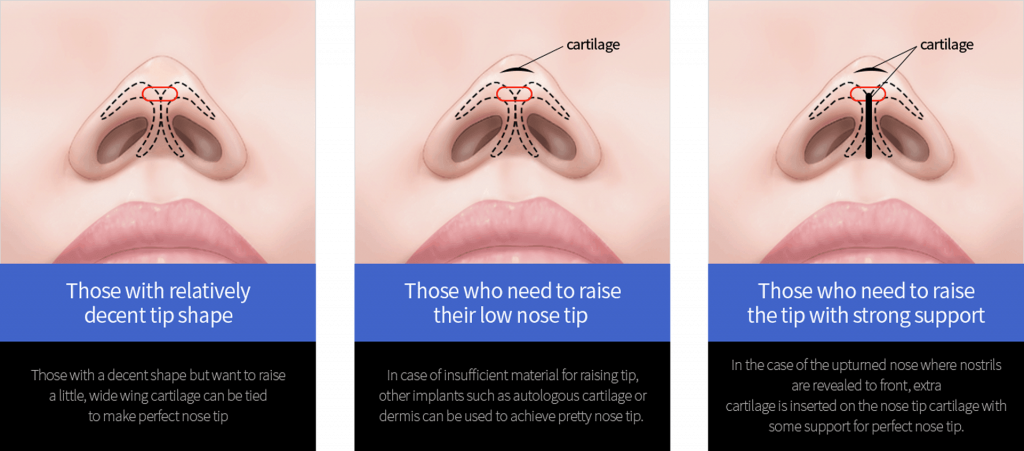
Surgery For Short & Upturned Nose
Ideal candidates:
- Individuals with a nose that is proportionally very short
- Individuals with overly exposed nostrils when looked at from the front
Surgery Method: Procedure for Upturned Nose / Short Nose Correction
When the patient’s nose is slightly short and the nostrils are not overly exposed:
- The surgeon inserts an implant or performs an autoplasty for lifting the glabella’s height and for giving a longer look to the nose.
- An ear cartilage is inserted before the tip of the nose to make it look longer. Other implants may also be used in place of the ear cartilage.
When the patient’s nose is extremely short and upturned and the nostrils are overly exposed:
- Re-Positioning The Alar Cartilages With Surgical Suture: We use a special suture method for re-positioning the alar cartilages without any cartilage graft. This helps in extending the nose length.
- Septal Extension Graft Using Septal Cartilage: Nose length is extended with the insertion of a septal nasal cartilage, costal cartilage, or donated costal cartilage.
- Nose Lengthening Procedure With Ear Cartilages: Ear cartilage can be used for extending the alar cartilage.
- Hybrid Septal Extension Graft: For individuals whose septal nasal cartilages are extremely small, this procedure is performed with septal nasal cartilages, donated costal cartilages, and ear cartilages for extending the length of the nose.
Surgery For Long or Arrow Nose
Ideal candidates:
- Individuals with nose length greater than 1/3 of their face
- People with drooping nose tip as much as it hides the nostrils completely
- Individuals with a short length between their lip and the nose tip
- Individuals with nose tip pointing downward when laughing or smiling
Surgery method:
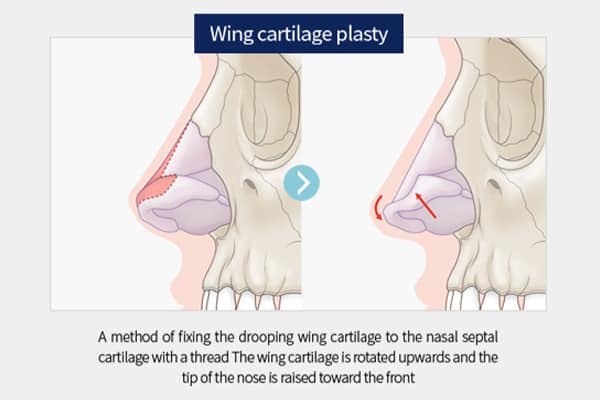
1. Wing Cartilage Plasty
This procedure works by rotating the wing cartilage upwards and fixating it in the same position so as to raise the nose tip higher.
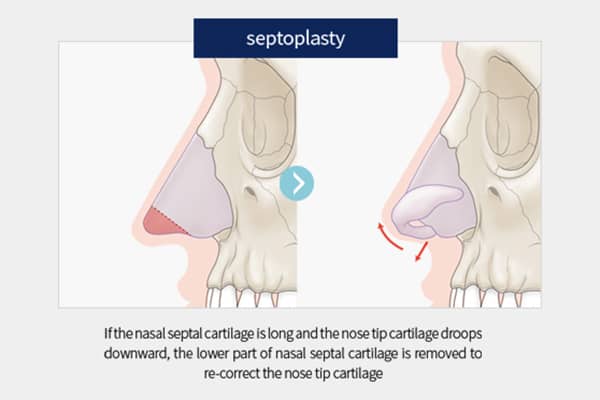
2. Septoplasty
When the downwards nose drooping is because of the very long nasal septal cartilage, this procedure is used for removing the lower section of the nasal septal cartilage so as to change the position and angle of the tip of the nose.
Reducing Nasal Hump (Humpectomy)
Ideal candidates:
- Individuals who have a bumpy and protruding nose bridge
Surgery Method
So, if you are interested in getting a rhinoplasty at Dream Singapore, get in touch and our medical team will guide you through the process.

Recovery From Nose Job in Singapore
After the procedure, there will be some pain, discomfort, swelling, and bruising. So, you will have to use antibiotics pills, creams, painkillers, etc, for a few days. A plastic splint or cast may be used to keep your nose in shape, which is removed after one week. Stitches are also removed 1 week after the procedure.
Initially, the recovery is very quick and there is significant reduction of swelling and bruising within 2 weeks after the surgery. The healing process, however, continues for the next 3 to 6 months. That is because collagen reproduction activities continue beneath the skin’s surface and it takes a few months before the healing cycle is complete. Hence, results stabilize few months after the procedure and one can judge the final results then.
Frequently Asked Questions (FAQ) about Rhinoplasty
Are There Any Side Effects Of Rhinoplasty?
Although the risks are minimal when done by a board-certified plastic surgeon but side effects, like bleeding, infection and swelling, etc, are associated with nose surgery. Other side effects may be related to general anesthesia like nausea, vomiting, sore throat, etc.
Can My Breathing Be Improved With Rhinoplasty?
Rhinoplasty involves nasal blockage risk but, in able hands, nasal breathing will not be compromised for the sake of achieving a particular cosmetic outcome.
A plastic surgeon is expected to maintain satisfactory nasal breathing after the procedure or correct any functional aspects where required. Certain breathing issues (like a slanted or squeezed nose) cause cosmetic anomalies and proper surgery planning can improve both appearance and breathing problems.
Cosmetic and nasal functional expertise are both needed for rhinoplasty procedures and an experienced plastic surgeon will be able to handle both aesthetics and functional aspects of the procedure.
How’s The Recovery Like After Rhinoplasty?
Little to no pain is experienced in most cases and pain alleviating drugs can easily control any discomfort. During the recovery period, patients must refrain from blowing their nose or putting weight on the nose in case of individuals glasses wearing. Patients with glasses shall be briefed on how they can manage glass wearing after the procedure.
Bandages on the inside and outside of the nose are removed 7-10 days after the rhinoplasty procedure. Areas around eyes tend to swell and bruise which is normal. The use of icepacks or cold wrappings can be applied to control swelling. It takes 2-3 weeks for contusions to recede and slight marks can be hid by minimal makeup.
‘Post-surgical blues’ is an emotional but completely normal phenomenon experienced by patients right after any medical procedure. Rhinoplasty patients feel better when the results start to unravel after a month and continuously improve over a year. Inflammation can take 6 months to a year to diminish fully.
How Much Does An Average Rhinoplasty Cost?
The plastic surgeon discusses the various aspects of the surgical procedures with patients before concluding with a personalized treatment plan. Different nature of problems causes the prices of rhinoplasty to vary for every patients. Operating procedure, anesthetic technique and patient’s level of requirement dictates the price for the rhinoplasty procedure.
For more information on the cost of rhinoplasty in Singapore, read our guide here.
Are Male And Female Rhinoplasty Different?
Male and females are structured differently and the same goes for their noses. Male noses will in general be bigger than female noses, with a more extensive dorsal protrusion. Female noses will in general have a more calculated shape when seen from the front and under. Sometimes, female patients favor a gentler and softer look to their nasal forms.
Apart from that, every individual has a different nasal structure and it’s analyzed in detail as a part of surgery planning before advising the potential outcome one can expect from their rhinoplasty procedure.
Does The Medisave Or Insurance Cover Nose Surgery For You?
Insurance companies cover the health expenditures of those procedures which are meant for rectifying a medical condition. So, as long as you are undergoing nose surgery to treat issues, like, difficulty in breathing, snoring, obstructive sleep apnea, injuries, fractures, or congenital abnormalities like cleft lip or palate, etc, they will be covered under Medisave or insurance plans.
However, you cannot redeem the benefits of health insurance plans if your nose surgery is solely meant for improving the appearance of your nose, for instance, to narrow your nostrils, to lift the nasal bridge, or to get the nose tip in a better shape, etc.
